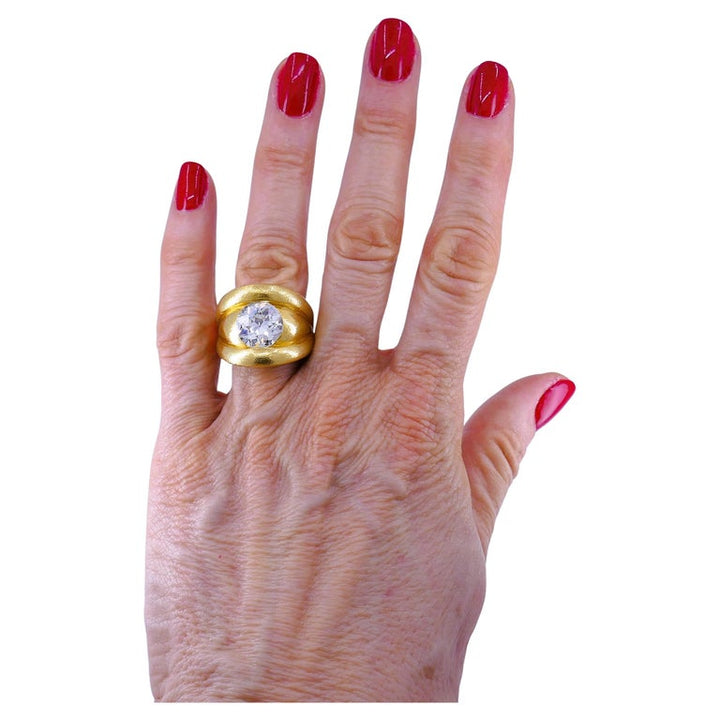70724-AIOOO 3-24
An impressive chunky 18k gold band ring featuring an Old European cut diamond.A striking combo of the big (4.86 carats) diamond mounted flush in the gold creates a great look. The gold is slightly textured which adds to the massiveness of the ring. Rounded sculptural edges perfectly frame the diamond.Whether it's a big party or an important meeting, this diamond ring will make a powerful statement wherever you go.
Sculptural design transformed the aesthetics of vintage jewelry. During the Art Nouveau and Art Deco eras, there was a profound shift in artistic taste that greatly impacted jewelry making. Fluid lines, organic forms, and geometric precision became integral to the creation of vintage jewelry. Artists and jewelers drew inspiration from nature, architecture, and the visual arts movements, infusing their pieces with a sense of eloquence.
In vintage jewelry making, sculptural elements conveyed narratives and evoke emotions.
The Art Nouveau movement, for instance, embraced sinuous lines and flowing curves inspired by natural motifs. These organic forms were meticulously sculpted into jewelry, creating pieces full of movement and grace.
On the other hand, the Art Deco movement favored bold geometric shapes, symmetry, and intricate patterns influenced by modern art and design. Sculptural elements in Art Deco jewelry often featured precise angles, stepped motifs, and sleek, streamlined designs that mirrored the spirit of the Roaring Twenties.
The sculptural design impacted the very techniques and materials in jewelry making. Makers experimented with intricate metalwork, employing techniques like chasing, repoussé, and filigree to create sculpted details.
The fusion of sculpture and jewelry during these eras passed the test of time and keeps being implemented in modern jewelry making.
Wearing rings on different fingers has been associated with various meanings across different cultures. While these meanings can vary widely depending on context and personal interpretations, here are some common associations.
In general, thumb means strength and is used to express willpower. Rings worn on the thumb are often seen as a symbol of authority. In some cultures, it can represent wealth and status. A ring on the thumb may also symbolize independence and self-reliance.
The index finger is associated with leadership and ambition. Rings worn on this finger can signify confidence and a desire for control. In some cultures, a ring on the index finger may also symbolize power and direction.
The middle finger is typically the longest finger, making it a focal point for rings. While wearing a ring on this finger may not have specific traditional meanings, it can symbolize balance and stability. Some people choose to wear a statement or cocktail rings on the middle finger to draw attention and make a bold statement.
In most Western cultures, the ring finger, also known as the “wedding finger,” is traditionally reserved for wedding bands and engagement rings. This finger has a symbolic significance associated with commitment and partnership. In some cultures, the ring finger is believed to have a vein directly connected to the heart, reinforcing the romantic symbolism of rings worn on this finger.
Rings worn on the little finger are often associated with style, sophistication, and self-expression. Additionally, wearing a signet ring on the pinky has historically been a symbol of family heritage.
It's important to emphasize that these meanings are by any means not universal. Ultimately, the significance of wearing a ring on a particular finger is subjective and can hold different meanings for different people.
Adult signature required upon receipt
Pick up in store available.
9454 Wilshire Blvd, Suite M-20,
Beverly Hills CA 90212
(310) 860-9991
Tues – Fri 11:30am – 5:30pm
Sat 10:30am – 4:30pm
Closed Sundays & Mondays
We accept returns within 3 business days of receipt, providing that the item is still in its original packaging and is free from damage.










